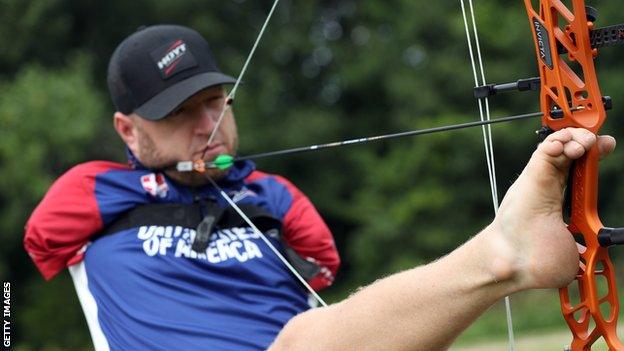Para-archery at Tokyo Paralympics: All you need to know
- Published

American Matt Stutzman, known as the Armless Archer, will be competing at his third Paralympics in Tokyo
Paralympic Games on the BBC |
|---|
Venue: Tokyo, Japan Dates: 24 August-5 September Time in Tokyo: BST +8 |
Coverage: Follow on Radio 5 Live and on the BBC Sport website |
Key information
Dates: 25 August-4 September
Venue: Yumenoshima Park Archery Field
Gold medals on offer: Nine
How does it work?
In Paralympic archery, archers compete in three classes - W1, open compound and open recurve.
The W1 classification is for the most impaired archers, who may have an impairment in their legs and use a wheelchair. They may shoot either a recurve or compound bow modified from standard rules but there are not separate competitions for the two disciplines.
The open classification is for competitors with an impairment in either the top or bottom halves of their bodies. Some athletes may use a wheelchair but others who have balance issues may shoot resting on a stool or standing.
The recurve bow is the more traditional style of bow - when the string is drawn back, the curves of the bow straighten to give leverage when it is released - while the compound bow uses a system of levers and pulleys in order to fire the arrows.
In W1 competition, the compound bow draw weight is limited to 45lbs and archers are not allowed to use magnifying scopes or levelling bubbles in their sight but competitors in the compound open division can use them and the draw weight is 60lbs.
Targets have a diameter of 122cm and open recurve competitors shoot from a distance of 70 metres while open compound and W1 competitors shoot from 50 metres.
The target is marked with 10 concentric rings which increase in points value the smaller and the closer they get to the centre. A hit in the outermost zone is worth one point while a hit in the centre, the 'gold', is worth 10 points.
Each event includes a ranking round where each archer shoots 72 arrows (12 ends of six arrows each) before the archers enter the elimination rounds.
The winner in the elimination phase in the open compound and W1 events is the athlete who scores the most points across the five ends of three arrows in each head-to-head match. In the open recurve event, the winner is the first archer to score to six points with two points given to the one who gets the highest score over each end of three arrows.
In the event of a tie, an arrow-by-arrow shoot-off will be held, creating the possibility of a gold medal being decided by a single shot.
In the individual events, the top performers in the ranking round will receive a bye in the first elimination round because of the number of entries.
For the team events, teams are ranked according to the combined scores from the ranking round before proceeding to the knockout stages.
Who are the British medal hopes?
GB led the medal table in Rio with Jess Stretton winning gold, aged just 16, but since then has changed category from the W1 to the open compound event. But the switch has paid dividends and she won individual and team silver at the 2019 World Championships.
Who are the other challengers?
China were hot on GB's heels in Rio and were the leading nation at the 2019 Worlds, just ahead of Russia. Elsewhere, Iran's Zahra Nemati, who carried her nation's flag at the opening ceremony in Rio, is bidding for three in a row in the recurve open event while David Drahoninsky of the Czech Republic, the W1 champion from Beijing in 2008 and silver medallist in London and Rio, will hope to be top of the podium again.
Did you know?
Archery was part of the first edition of the Stoke Mandeville Games - the predecessor of the Paralympics. Sixteen injured servicemen and women competed in the event in July 1948 under the supervision of Ludwig Guttmann.
ParalympicsGB Rio 2016 medals
Six (team gold - John Walker & Jo Frith; individual gold - John Walker, Jess Stretton; individual silver - Frith, team silver - John Stubbs & Jodie Grinham; individual bronze - Vicky Jenkins)